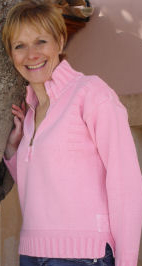Pigment Dyeing
Pigment dyes are useful to give a washdown casual look on leisurewear. These dyes are less precise than reactive dyes as colour matching cannot be so precisely achieved. This is because the process involves 3 main stages. The first stage is to treat the fabric with a cationic product. This in effect makes the fabric more readily accept pigment dye molecules that do not really penetrate the fibres as other dye types but tend to sit on the surface of the fabric. This quality is how the washdown look is reached in the second stage.
The second stage is applying the pigment dye. With the machine turning quite quickly the pigment dye in liquid form, rather like paint, is introduced into the machine and is dispersed over the fabric. The machine turns quickly to ensure an even dispersal. During this part of the process the mechanical action of the machine and the fabrics rubbing on each other knocks off some of the dye. The dye is reduced particularly from the high spots such as seams, hems pocket edges and so forth. There is no separate washdown process as this dye cycle is usually sufficient to achieve the required look. As the dye only sits on the surface removing some of it by mechanical action reveals the undyed fibre. This gives the worn look associated with pigment dyes.The third stage involves processing with a binder. This is designed to keep the pigment dye attached to the surface of the fabric. Of course there are various rinse stages between the main processes and the final stage is usually a softening bath.
You will see how the result is dependent on completing all stages and a fair amount of mechanical action. This is why it is not practical to do lab dips as you would for reactive dyes. It is also why you need to process a number of garments together even when sampling to produce the desired effect.Pigment dye molecules are relatively large and easily filtered at water treatment plants and are therefore considered to be eco friendly. They are also processed at generally lower temperatures than reactive dyes and the process time is shorter. These factors further contribute to their eco friendly status.
Some advantages of pigment dyes include their ability to cover non-cotton fabrics at least to certain extent. So for example, some of our customers buy basic T-shirts and sweatshirts in white, which are nearly always sewn with polyester thread. (Polyester thread will not dye at all with reactive dye). This means the seams and other sewn parts; button holes etc will accept at least some of the pigment dye. A white T-shirt dyed with reactive dye but sewn with polyester thread will dye perfectly to any shade but the stitching will remain white. Of course garments known as PFD – prepared for dyeing – will be sewn with cotton thread and this is ideal as they can be dyed with any dye type and the stitching will dye too.Some types of cotton knits, often the lower quality ones, may pill to a certain extent with the mechanical action during pigment dyeing. This can usually be corrected with an enzyme treatment, which removes the pilling, and smoothes the fabrics.
Pigment dyes can give a huge variety of shades including bright colours. They do have limitations when trying to reach very dark or deep shades. For example a deep black is not possible, using pure black pigment will result in a dark grey. Also unlike reactive dyes pigment dyes cannot be stripped. They may be modified by applying another shade on the top to lighten or change the appearance but you cannot remove all the colour and start again.

If you would like any further information about pigment dyeing please contact